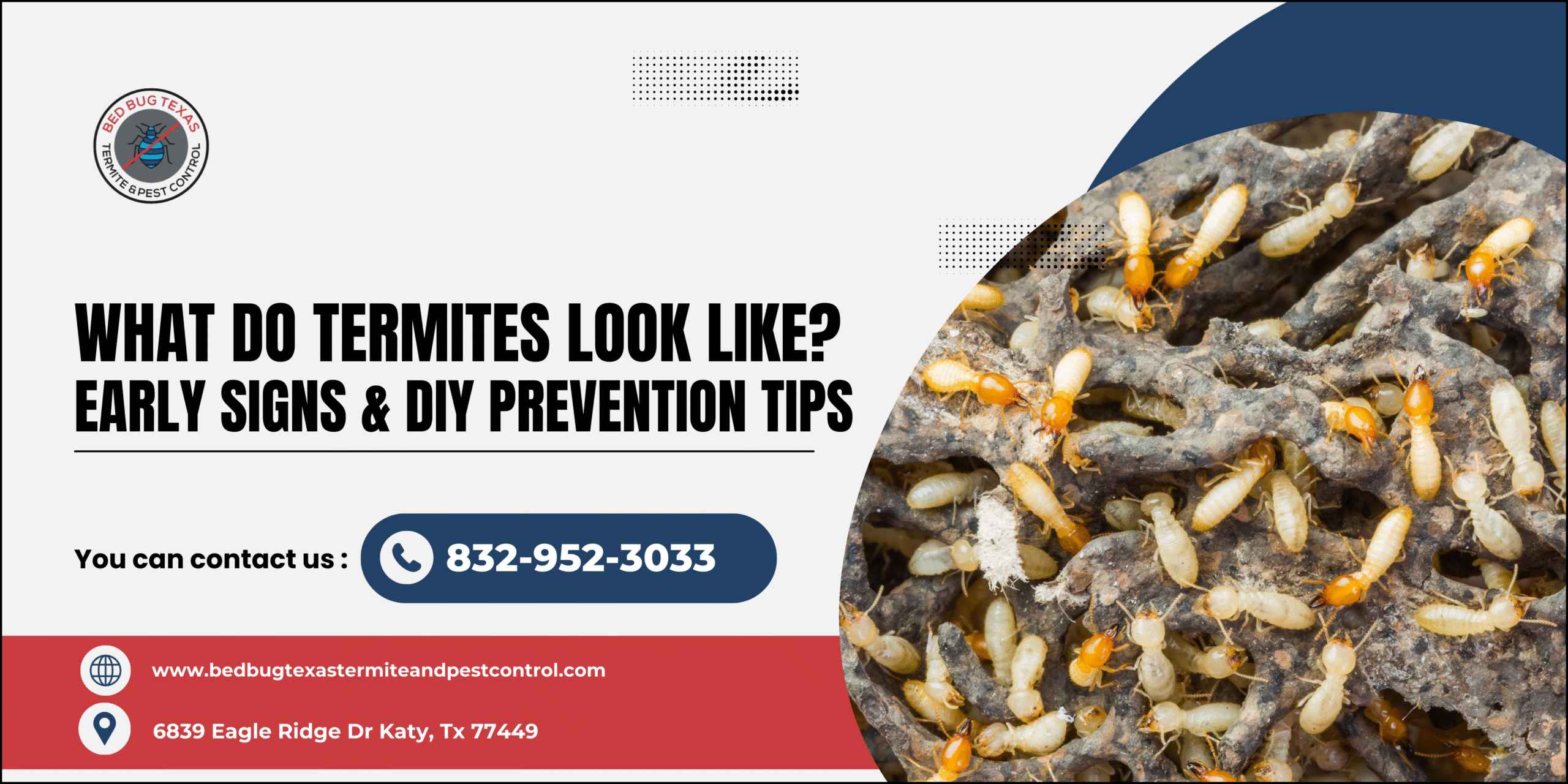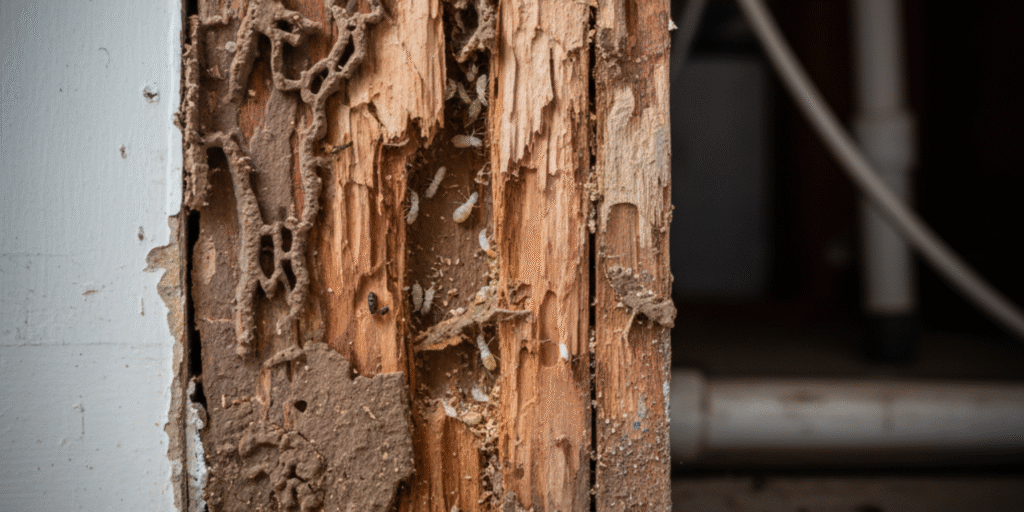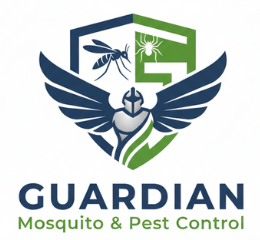
Termites are one of the most destructive pests on the planet. They are quiet, efficient, and very good at hiding until they have already eaten the structure around your home. If you want to protect your home, you need to know exactly what termites look like, how to spot the early warning signs of termites, and what DIY prevention steps actually work. This guide will strip away all the myths and will get straight to the point. Let’s get started.
Quick Definition: What Are Termites?
Termites are social insects that feed on cellulose, which is mostly wood. They live in colonies with clearly defined roles (we’ll talk about this further in the article). Unlike ants, termites chew through wood from the inside out and leave surfaces hollowed out. You can literally tap against the wooden surface and find out if it’s affected by the termites or not.
What Do Termites Look Like?
- Workers: These are the ones you’ll see inside the wood or mud tubes. Pale/cream to light brown, soft-bodied, about ⅛”-¼” long. Another thing is that these worker termites are usually eyeless or have tiny eyes, depending on the species.
- Soldiers: Soldier termites have slightly larger heads with powerful jaws (mandibles). So, if you see big-headed tiny bugs guarding mud tubes, that’s a soldier.
- Swarmers (Winged Reproductives): They have darker bodies with two pairs of wings. They fly out by the hundreds during the mating season. If you find piles of discarded wings on a windowsill after a rain, that means you have an infestation.
- Baby Termites: As the name suggests, these are tiny versions of workers, pale and soft. If you find a cluster of almost transparent tiny insects inside damaged wood or mud tubes, you are looking at nymphs.
To give you a bonus tip for identification: termites have straight antennae and a more uniform body shape. Ants have elbowed antennae and a waist. Do not confuse the two unless you want to waste time and money.
Early Signs of Termites You Tend to Dismiss
Termites are stealthy. One or two of these signs might be nothing. But several together is a total catastrophe waiting to happen. Watch out for these signs:
Mud Tubes (Shelter Tubes)
You’ll find them running up foundation walls, piers, or inside crawl spaces. These pencil-sized tunnels are termites’ way home. If you break open one, you’ll find live workers. This is one of the clearest signs of termite activity.
Discarded Wings
Swarmers are the colony’s reproductive dispersal stage. You’ll find them near windowsills, doors, or light sources. Seeing them inside is not a one-off; it means that new colonies might be forming.
Frass (Drywood Termite Droppings)
These are small pellet-like piles beneath small holes in wood. If you find that, you’re likely dealing with drywood termites, which live entirely in wood and don’t form mud tubes.
Hollow or Damaged Wood
Tap the wood around your house. If it sounds hollow or flakes away easily, that’s termite damage. Termites eat from the inside out, so surfaces may look fine while the interior is completely damaged.
Sticking Doors or Windows & Bubbling Paint
These can result from wood damage or moisture caused by termite activity. Alone, these signs can be a dozen things, but combined with mud tubes or droppings, they mean termites.
Faint Rustling Inside Walls
If you put your ear to the wall and hear a soft rustle, it could mean live termites feeding and roaming inside your walls.
DIY Prevention Tips That Actually Help
Prevention is where homeowners can win. These are high-impact and low-effort moves that could actually give you some results:
- Eliminate Wood to Soil Contact: Move firewood, lumber, porch posts, and planter boxes at least a foot from foundation walls. Put decking posts on concrete piers so that there is no soil contact.
- Fix Moisture Problems: Termites love damp wood. It is important to repair leaks and reroute downspouts so water drains away from the foundation. You can invest in dehumidifiers for crawl spaces as a cheap insurance.
- Seal Gaps and Cracks: Caulk open foundation cracks, seal gaps around utilities and pipes. Termites don’t always need large holes; they’ll exploit tiny access if the conditions are right.
- Consider Wood Treatments for New Construction: Applying borate-based preservatives makes wood less palatable for termites.
These are cheap, sensible, and effective steps at reducing risk.
Do It Yourself Treatment for Termites: What You Can Try And The Limits

- Bait Stations: These are a slower and targeted way to reduce colonies if installed and monitored properly. We would recommend professional installation because baiting requires correct placement and ongoing checks.
- Borate Sprays: It is great for treating non-structural wood. But you should note that it won’t reach colonies that are feeding through the soil.
- Localized Drywood Treatment: For very small drywood pockets, professionals can inject foam; there are DIY aerosols, but they rarely remove the whole colony. Frass and repeated activity often remain.
Spraying random bug sprays or using essential oil fixes as your primary strategy for an infestation will not work. Research often shows that homeowners who try “homemade” fixes end up paying for full treatment later.
Professional Termite Killers: Options For Homeowners
Advanced Soil Treatments and Termiticides
These help and create a chemical barrier between the soil and your structure. This is the standard for a termite infestation and is usually best done by a professional pest control company.
Fumigation & Heat Treatments
For severe drywood termite infestations, experts may tent the whole home and use gas fumigation, or heat the structure to lethal temperatures, depending on the size of the infestation.
Wood Treatments
Professionals can inject or surface-apply treatments to protect wood. It works well as a preventative measure during construction or remodelling.
Wrapping Up
Termites are a maintenance and inspection problem with clear signs and known remedies. You need to be proactive about moisture and wood contact, and please don’t let a YouTube hack convince you that a full-blown infestation can be handled on a weekend. Remember to call the pros when the signs add up.
FAQ
- Do Termites Bite?
No, termites do not bite humans. Their jaw are designed to chew through wood, not skin.
- Do termites have wings?
Yes, reproductive termites, called the swarmers or alates, grow wings during mating season. Finding discarded wings near windowsills is one of the early signs of termites indoors.
- Do termites thrive in heat?
Yes, termites thrive in warm and moist climates. Heat accelerates the activity and reproduction. However, extreme heat treatment is deadly to them, which is why professionals use heat as a termite killer in many cases.
- What do termites eat?
Termites feed primarily on cellulose, a compound found in wood, paper, cardboard, and plant material.
- Do termites bite people?
No, termites do not bite people, pets, or carry any diseases. Their threat is entirely structural, destroying homes silently from the inside out.l see spiders. That’s non-negotiable. But knowing the types of house spiders and which ones are dangerous can save you from needless fear (and useless extermination attempts). If DIY tricks feel like too much work or if the spiders keep coming back, get professional help and stop losing your sleep.
